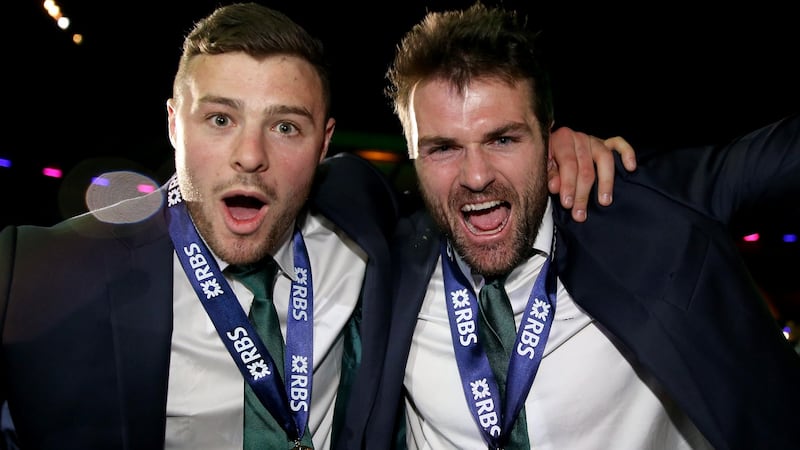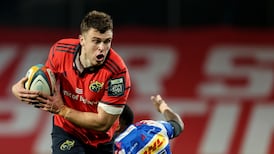He steps out and he steps in again. The next time Christy Moore entertains the Irish squad, as he's done before, Lanigan's Ball would seem particularly apt with the Irish midfield in mind.
No sooner had Joe Schmidt a full hand to choose from last week for the first time in two seasons than both Garry Ringrose and Robbie Henshaw are sidelined again and so Chris Farrell is reunited with Bundee Aki for the third time. It was ever thus.
In Schmidt's 63 games in charge, Ireland have used 16 centres in total, and in 27 different combinations.
Unlike any other combination in the Irish team, the midfield musical chairs is such that only twice since the start of last season has Schmidt been able to select the same centre combination foe two games in a row, and not once for three games in succession during that 17-game run.
The last time Ireland fielded the same midfield combination for three games in a row was in the Six Nations two seasons ago.
Ruled out
Ringrose was ruled out for the first three months of last season after undergoing a shoulder operation. This was offset by Aki becoming eligible when partnering Henshaw on his debut in the 38-3 win over South Africa.
After Farrell made his debut outside Stuart McCloskey against Fiji, Aki and Farrell were the partnership for the win over Argentina when Henshaw was sidelined after straining his hamstring in training that week.
Then, in his fifth comeback game for Leinster, Ringrose suffered syndesmosis of the ankle against Ulster and was ruled out of the first three games of last year’s Grand Slam campaign.
The Aki/Henshaw combination was reprised for the miraculous escape to victory in Paris and the ensuing win over Italy. But, in the act of scoring his second try, Henshaw dislocated his shoulder, and Keith Earls moved in from midfield for the last 35 minutes.

Farrell returned for the win over Wales, again outside Aki, when man of the match, only to twist his knee at the end of an open session at the Aviva Stadium, resulting in an operation on his damaged ACL which ruled him out until late last November.
You couldn’t make this stuff up.
All this while virtually every other sector of the team remained settled during the Grand Slam campaign, before Ringrose returned to shine alongside Aki in the wins over Scotland and England.
Even then, the previously indestructible Aki limped off with a leg injury at Twickenham for Jordan Larmour to slot in alongside Ringrose for the last 25 minutes in what amounted to Ireland’s sixth midfield partnership in the five games.
It was back to Lanigan’s Ball in the three-Test series in Australia, when Ringrose, Aki and Ringrose were sidelined in turn.
Last November, Aki and Ringrose started against Italy in Chicago, and after Henshaw was recalled against Argentina, he pulled up in the warm-up with a hamstring issue, meaning Will Addison was a late call-up to partner Aki. Cue Ringrose’s hamstring strain against England last week, and then Henshaw’s dead leg.
Ironically, Schmidt inherited the most-capped and most celebrated Irish midfield partnership of the lot, namely Gordon D’Arcy and Brian O’Driscoll.
In all, the pair started 56 Tests together. Schmidt got the last six of those, culminating in the 22-20 win in Paris in March 2014 which clinched the Six Nations title.
Schmidt clearly identified partnerships to succeed the celebrated duo. Firstly, there was the Henshaw and Jared Payne combination, then Henshaw and Garry Ringrose, and latterly Aki with either of Henshaw or Ringrose.
The best laid plans of men and mice.
It is a measure of the injuries which have since afflicted the Irish midfield that D’Arcy and O’Driscoll’s six games together has only been overtaken by one other combination in Schmidt’s tenure, namely the Henshaw/Payne axis, for 13 Tests.
Nice start
This began with 2014 Guinness Series opener against South Africa, which Ireland won 29-15. "It was a nice start," recalls Payne of a game which also marked his debut. "That game is always a good memory. I was pretty nervous. I hadn't thought too much about the game; I was worried about singing Ireland's Call. I spent most of the week learning the whole thing and learning my song for the team bus afterwards. The game kind of came second," he jokes.
Whereupon a foot injury sidelined him for three months.
But they resumed their partnership and were ever present in the 2015 Six Nations title, culminating in a 40-10 win in Murrayfield on that Super Saturday when Payne was among the try scorers.
“I’ll never forget that day. It was pretty special everything that happened. I don’t think you could have written it any better.”
Nothing beats matches according to Payne. “Defensively, you learn to trust the guy inside you,” says Payne, such as reading when his partner might push up and doing so with him, or if drifting to have his inside shoulder covered, something he could trust Henshaw to do.
Likewise, in attack, learning if his partner likes to play flat, getting the ball into his hands early and use his footwork, and for all the repetitions in training “there’s nothing like proper game time”.
“You try to develop an instinctive relationship in attack and ‘D’, and after a few games you can pre-empt what they’re going to do to work with them.”

“I’d tell Robbie what I wanted out of him and he’d tell me what he wanted out of me. At first it was very much a work in progress. It was a testament to him, because he had played a lot more at fullback then and was just starting in the midfield at ‘12’. He showed what a talented footballer he is to be able to slot in there and do as good a job as he did.”
Henshaw has played 32 times at centre, with Payne joint second on 17 alongside Ringrose, in the Schmidt era.
Henshaw and Payne were meant to be the midfield pairing for the World Cup before the jinx struck again.
“I stripped some muscles off the bone in my foot against Romania,” recalls Payne. “We tried to rehab it and injected it to take the pain away. Then I was good to go but unfortunately my foot flared over the next few days. We got it X-rayed and I had broken my foot in training, so I had to pull out of the World Cup, which was not one of my career highlights.”
Schmidt resorted to a partnership of Henshaw and Earls for Ireland’s crucial final pool games against Italy and France, as well as the quarter-final against Argentina. It remains the only three times the pair have started in midfield together, and yet only five other partnerships have started more Tests in the last six seasons.
Henshaw and Payne were together again for other big wins, such as against the All Blacks in Chicago November 2016. “I think, from memory, we did an all right job, didn’t we?” Payne says with a laugh.
As for choosing the 2015 title or Chicago, he says: “Oh shoot mate, it’s a toss of a coin. Chicago was a pretty unreal day but then I don’t think I’ll ever experience anything like that Six Nations again. It was a pretty awesome ride the whole day.”
Carnage
In the return meeting at the Aviva two weeks later, amid the first-half carnage, Henshaw was replaced after 10 minutes by Ringrose.
“Jeeze, it was a physical test that one, wasn’t it?” Says Payne dryly. “You’re never going to poke the bear and not expect a reaction. We definitely got one that day. You hear a lot of people say it was out of order or whatever, but it was just a pretty tough physical Test match.”
That was their last game together but Henshaw and Payne remain, by some distance, Ireland’s most established partnership under Schmidt.
“He works unbelievably hard,” Payne says of Henshaw. “He puts his body on the line inside you and he’s a good talker. He’s a pretty talented footballer as well.”
But it should have been more. Way more. Then, partnered with Ringrose a week later, Payne suffered a fractured kidney in the first half of the win over Australia at the Aviva Stadium (leading to Earls partnering Ringrose for the second half).
Payne’s admiration for Ringrose is clear. “He’s class. He’s already very good, but I think he’s just going to get better. He’s very good at defending space and pushing up and making tackles.
“Then on attack he’s pretty special. He’s got unbelievable footwork, good acceleration and I think he’s learning more and more when to pass the ball, and when not to, and he’s starting to put other people in space, and as soon as he really masters that he’s going to be the complete ‘13’. I think he’s going to be one of the world’s best over the coming years.”
Payne would play only once more for Ireland, at fullback in the 2017 Six Nations finale against England, when earning his 20th and last cap before concussion issues forced his premature retirement.
Payne, now the Ulster defence coach, never got to play with Aki, but did play against him in Ulster-Connacht games. “He’s a competitor, he gets stuck in. He’s a smart footballer, and he’s got all the physical attributes. It’s good to see him go well. I had a few run-ins with him in Connacht matches, as you do, but I definitely rate him as a footballer.”
“He’s smart and he makes good decisions and physically is very strong and abrasive as well, so he’s pretty complete for a ‘12’ really.”
Only once has Aki been ruled out by any kind of injury, and today will mark his 14th start in Ireland’s last 17 Test matches.
Bundee has become the steady partner in the Irish midfield's version of Lanigan's Ball.
Touch wood.













